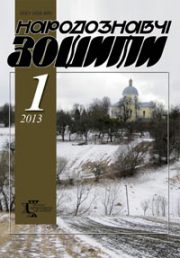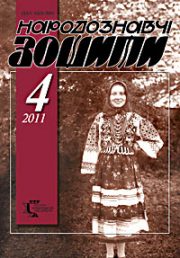The Ethnology Notebooks. 2024. № 5 (179), 1150—1156
UDK [61:615.89](477.86-13-11)”19/20″
DOI https://doi.org/10.15407/nz2024.05.1150
FAINYK Tetiana
- ORCID ID: https://orcid.org/0000-0001-8446-4002
- Doctor of Philosophy, senior researcher fellow
- of the department of Modern Ethnology
- of the Institute of Ethnology
- The National Academy of Sciences of Ukraine,
- 15, Svobody Avenue, 79000, Lviv, Ukraine,
- Contacts: e-mail: t.faynyk@gmail.com
Abstract. Introduction: Pokuttia is a picturesque corner of the Carpathian region, where many folk traditions have been preserved, in particular in folk medicine. Hard daily work, isolation due to weak communication, inaccessibility and high cost of qualified medical care were the reasons for the existence of folk methods of treatment and the existence of witchcraft. Belief in the magical power of words existed so deeply among the people that they wanted to use them to influence the removal of natural disasters and all kinds of diseases.
The problem of the article involves a review of the historical environment in which health is the norm of human existence, while illness violates this norm, accordingly, a person throughout his existence fights with illness, passing on certain knowledge about medicines and methods of treatment. This is how folk medicine was born, which absorbed everything from the time when the world was perceived as a whole, with its positive and negative. Belief in the healing power of plants, in a good word, certain superstitions, which are reflected in many rites, orders, songs, certain rituals, own practices and life experience, are a whole system of folk healing wisdom.
The relevance lies in the researched history of medicine, because it contains rich material from the history of the people and its worldview.
The purpose of writing the article is an attempt to highlight the state of medical practice and human health in Pokutta and the place of folk medicine in it.
The object of research is folk medicine in a historical aspect, and the subject is the attitude of the population to diseases and their treatment. For the first time, an attempt was made to highlight and explain the impact of social, cultural, communicative and other factors on the state of health of the population of Pokuttia during the research period.
The methodological basis of the research is the complex application of a number of general scientific methods, the main of which are historical and typological analyses.
Keywords: folk medicine, history of medicine, medical practices, ethnography, folk traditions, culture, sanitation and hygiene.
Received 3.10.2024
REFERENCES
- Myhulko-Gorbatsevich, Gr. (1928). Ukrainian medical archive. Ethnography and medicine (Vol. II, notebook 3). Kharkiv [in Ukrainian].
- Kolberg, O. (1887, 1888). Pokucie: an ethnographic image (Vol. 3, pp. 145—174; vol. 3, pp. 96—178). Krakow [in Polish].
- Mrochko, Ks. (1977). Snyatynshchyna: reasons for regional ethnography: in 3 parts. (Part I). Detroit [in Ukrainian].
- Kozachenko, T. (2015). Contribution of Polish researchers to the study of folk medicine of Ukrainians (second half of the 19th — first half of the 20th century). In: Between. Polish and Ukrainian Studies, 1 (Part 1, pp. 179—191) [in Ukrainian].
- Talko-Hryncewicz, I. (1893). Outlines of folk medicine in Southern Ruthenia. Krakow [in Polish].
- Nosal, M.A., & Nosal, I.M. (1959). Medicinal plants and methods of their use among the people. Kyiv [in Ukrainian].
- Dumka, M. (1968). Medicine of Carpathian Ukrainians. Folk creativity and ethnography, 5 [in Ukrainian].
- Komendar, V. (1971). Medicinal plants of the Carpathians. Uzhhorod [in Ukrainian].
- Karhut, V. (1993). Medicines around us. Kyiv: Zdorov’ya [in Ukrainian].
- Boltarovych, Z. (1980). Folk treatment of the Carpathian Ukrainians of the late 19th and early 20th centuries. Kyiv [in Ukrainian].
- Bruskov, V. (2011). Healing herbs Pokuttia. Yamhoriv Literary, regional and artistic almanac (Part 18—19, pp. 222—228). Sniatyn [in Ukrainian].
- Vorobets, Yaroslav, & Tkachuk, Volodymyr. (1997). Ways of searching for health. Memories, stories, references (P. 24). Sniatyn: Prut-Print [in Ukrainian].
- Khariton, Vasyl, & Tymofiychuk, Mykhailo. (2006). Snyatyn over the Prut (P. 138).Sniatyn: Prut-Print [in Ukrainian].
- Boghaichuk, Ya. (2003). On guard of health of Tlumachchyna: history of medicine of Tlumachchyna in names. Association of intelligentsia «Progress». Ivano-Frankivsk: Nova Zorya [in Ukrainian].
- Smerechansky, Roman, Kaglyan, Oleksandr, & Myronyuk, Ivan. (2014). Ages of past strongholds. Horodenkivshchyna in old documents and photos. Ivano-Frankivsk: Lileya NV [in Ukrainian].
- Kaindl, R.F. (2000). Hutsuls: their life, customs and folk tales (P. 208).Reprinted from: Vienna: Imperial and royal bookseller Adolf Golder, 1894. Chernivtsi [in Ukrainian].
- Figlevskii, V. (2011). Ivan Podyuk is a doctor-humanist, a fighter for a healthy way of life in Pokutta. Yamhoriv Literary, regional and artistic almanac, 18—19, 96—104 [in Ukrainian].
- Bazhanskyi, M. (1984). They will live forever… Figures from the dawn of history to the most recent times. Biographical dictionary. Detroit [in Ukrainian].
- Franzos, Carl Emile. (2008). Essays on the culture of Galicia, Bukovyna, Southern Russia and Romania (1878). From Vienna to Chernivtsi. From the Austrian-German Ukrainika of the 18th and 19th centuries (Part 1). Lviv [in Ukrainian].
- Bazhanskyi, M. (1983). Creative dynamism of the patriotism of my compatriots. From the first manifestations of organized social circles of church brotherhoods, craft workshops — all the way to «Sichey», «Sokols», «Prosvit», «Native schools» and combat formations. Password encyclopedia. Detroit [in Ukrainian].
- Mohoruk, D. (2005). My village Toporivtsi. Historical, regional and ethnographic essay: in 6 vol. (Vol. I). Snyatyn: Prut-Print [in Ukrainian].
- DAIFO. F. 2. Op. 7. Case 511. Arc. 21—31 [in Ukrainian].
- (1928, september 15). Dilo. Lviv [in Ukrainian].
- Andrukhov, I., & Gavrilyuk, S. (2008). Tysmenitsa. Ivano-Frankivsk: Lileya NV [in Ukrainian].
- DAIFO. F. 909. Op. 1. Ref. 1186. Arc. 5 [in Ukrainian].
- Sacher-Masoch, L. (father). (2008). Polish revolutions. Memories from Galicia, 1863. From Austrian-German Ukrainian studies of the 18th and 19th centuries (Part 1, p. 103). Lviv [in Ukrainian].
- Kupchynskyi, B. (2011). Tyshkiv «Golden Brotherhood» of sobriety. Yamhoriv Literary, regional and artistic almanac (Part 16—17, pp. 41—46). Sniatyn [in Ukrainian].
- Archive of the National Academy of Sciences of Ukraine. F. 1. Op. 2. Spr. 797 [in Ukrainian].
- Vorobets, Ya. (2009). Separate information on the history of medicine in the Snyatyn Region. Yaroslav Vorobets, Mykola Zinkovskyi, Mykola Dovzhynskyi. Colleagues Snyatynshchyna has been medical throughout the centuries. Chronicle of the region (Pp. 34—35). Prut-Print Sniatyn [in Ukrainian].
- Ozarkevich, E. (1999). «Hygienic and medical adviser. Diseases of the world». Lviv: «Prosvita»; Doctor Yevhen Ozarkevich (P. 111).Lviv: Kamenyar [in Ukrainian].







